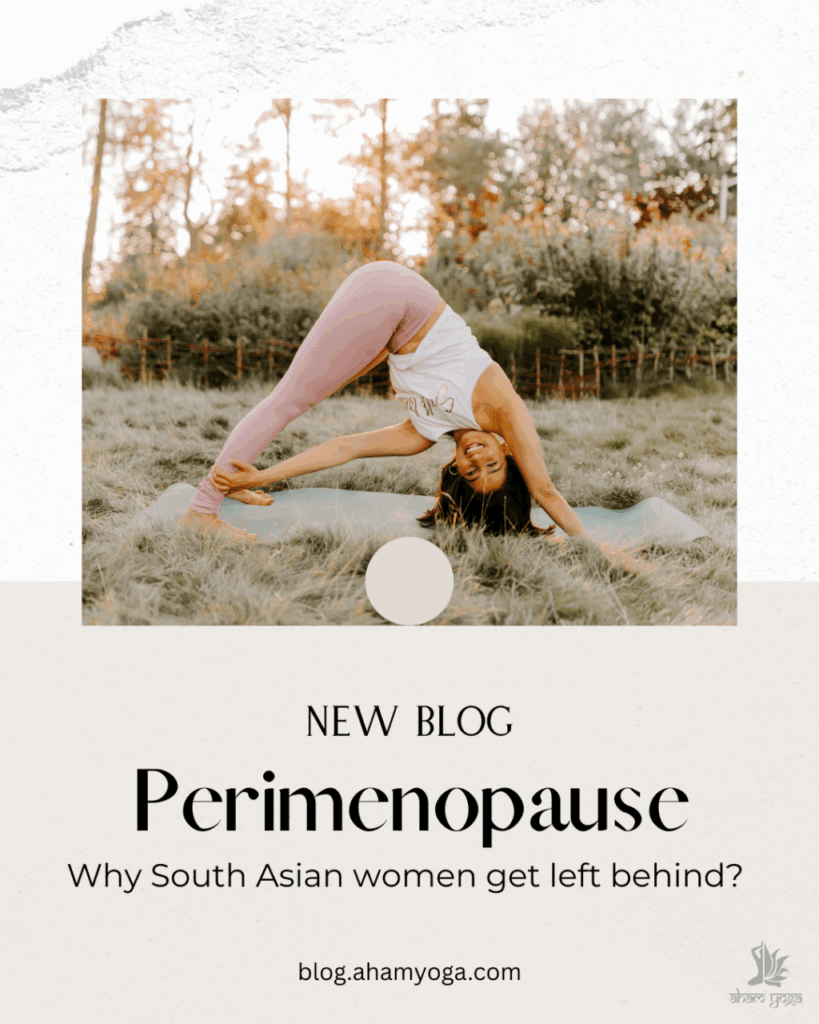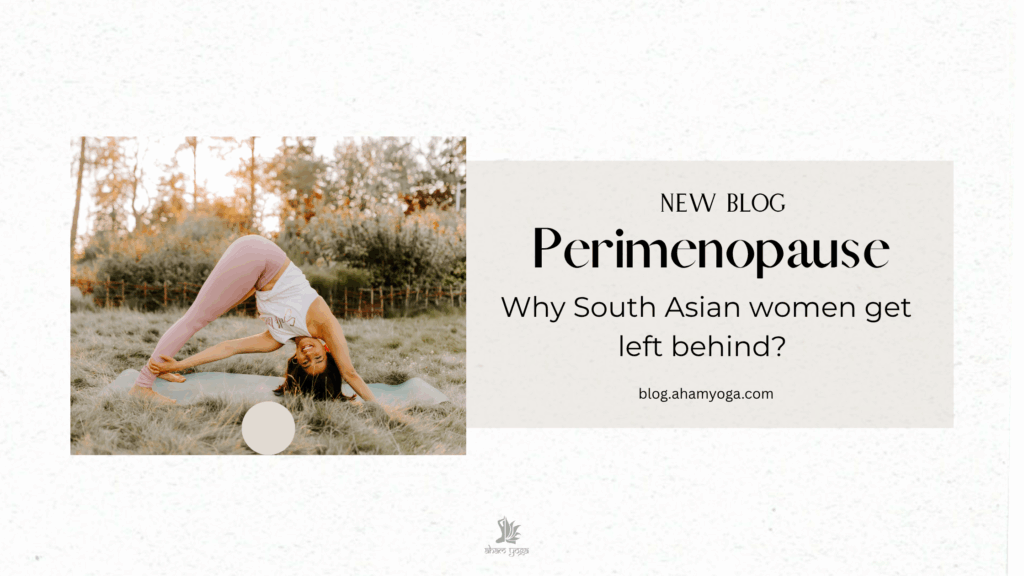Perimenopause is a phase that many women around the world, including South Asian women, experience. Yet it often remains unspoken. Growing up in India, and in many South Asian cultures, conversations about menstrual health, reproductive health, and menopause have traditionally been limited. This cultural silence means many women reach their late 30s and 40s without even knowing what perimenopause is. And are often confused when the symptoms show up.
What I believe is lacking is awareness and conversations around perimenopause. After 12 years of running Aham Yoga, Let’s Talk Yoga podcast & having countless conversations with women, mainly of South Asian and Indian descent. I’m taking these out of the studio community circles and sharing what little I know hoping that it helps you or someone you know. Truth is when you’re under 35 you may not feel the need to know this. It is only when things start to shift that this becomes significant.

In this blog, you will understand…
- What is perimenopause?
- What is the difference between perimenopause and menopause?
- The symptoms
- Navigating perimenopause
- Yoga as a tool versus other disciplines
- What next if you’re in perimenopause?
What is Perimenopause & Menopause?
Perimenopause is the transitional period leading up to menopause—the point at which a woman has not had a menstrual cycle for 12 consecutive months. Perimenopause can begin as early as the mid-30s and is marked by fluctuating hormone levels. This transition often brings physical, emotional, and mental changes that can be confusing without proper information and support. Perimenopause lasts anywhere from 3 to 8 years before menopause hits. The modern lifestyle adds further to the enhanced experience of perimenopause.
Common Symptoms of Perimenopause
Every woman’s experience with perimenopause is unique. Which sometimes adds to the complexity of finding uniform solutions for it. Some of the most common symptoms include but not limited to:
– Brain Fog: Decreased clarity, focus, and memory.
– Mood Swings and Low Mood: Irritability, anxiety, and periods of depression.
– Changes in Menstrual Cycle: Irregular, shorter, or longer cycles.
– Weight Gain and Fatigue: Hormonal shifts may cause unexplained weight gain and exhaustion.
– Changes in Libido: Fluctuations in sexual desire.
– Headaches and Migraines: Increased frequency or intensity.
– Hot Flashes and Night Sweats: Sudden waves of heat and perspiration.
– Sleep Disturbances: Trouble falling or staying asleep.
– Vaginal Dryness: Can cause discomfort and pain during intimacy.
– Joint Pain, aches and injury: Often reported but overlooked.
Why Awareness Matters
According to a 2022 survey by Bonafide Health, nearly 73% of women said they were not aware they were in perimenopause when they first started experiencing symptoms. Another study published in the Journal of Women’s Health found that over 50% of women felt unprepared for the perimenopausal transition. In many South Asian communities, this lack of awareness is even more prevalent due to cultural taboos around sexual & reproductive health. Women are often massive caregivers for adults and children in the household. And tend to minimize their suffering to not disturb family dynamics. Often neglecting their needs for others. But this has to change.
Navigating Perimenopause
The strategies that worked in your 20s and 30s may not be as effective now. Aligning physical activity with your menstrual cycle is helpful. And honestly much needed. It will make the transition a little smoother. The first two weeks post-period are often ideal for higher intensity workouts, while the latter half may benefit from restorative and gentle movement.
In the Indian community there exists a fratured view of the physical body. The need to be thin, to count calories, obsesses over what you eat or don’t eat or feel less than because you are in bigger body, fat shaming all of these exist and women often silently internalize these traumas.
Men are often left out of this conversation. A man can gain weight and no one will blink. But if a women has a little bit of weight on her, you will notice a different reaction. There is a lack of boundaries for body issues but that’s a topic for another day.
What a woman needs during perimenopause is not judgement but compassion, support, community and clarity on how to cope in the best way possible.
Approaching Working Out in Perimenopause?
Yoga can be a powerful ally in this journey. Yoga takes a multidimensional view of the body. So it doesnt just treat the physical body. But also looks at the energetic body and the mental body. You address your physical, energetic, mental and emotional needs. So many women, make the mistake of trying more HIIT classes or take up running instead of showing up at yoga class. While I’m not asking you to stop HIIT classes or running, I’m asking you to supplement with some yoga. Especially the 2 weeks prior to your period.
After 20 plus years of being in the health, fitness and wellness field here is the holy grail you should be aiming for…
- Yoga – Preferably a yoga class where a teacher can see you and address your needs. (Aham Yoga livestreams all our classes). Twice a week would be ideal.
- Weight Training: Muscle atrophy is common during perimenopause. Women lose muscle faster then men. Adding some moderate to gentle weight training is essential if you ask me. It will help you age better and working out will aid mental, physical and emotional health too.
- Gentle cardio: A dance class once a week. Or a mild hike with a soft incline. Avoid mid day sun if you can help it. (If you’re local and looking for cardio – check out BollyWorks fitness classes)
There are also the more subtle notes of vairajya (detachment) and asteya (nonstealing) from yourself. To embrace a changing body. To practice more Patipaksha Bhavanam (cultivation of the opposite) when you catch yourself in a negative spiral and so much more. Yoga is the best tool for perimenopause.
Community and sisterhood are essential. When women share openly, we reduce isolation and build understanding. This blog is part of an awareness campaign by Aham Yoga to create space for these necessary conversations.
Why Yoga is Ideal?
Like I mentioned earlier, yoga works on ALL aspects of you. Not just the physical. So much of perimenopause is a emotional and mental experience. Often times, women feel reasonably fine physically but can be overwhelmed mentally. Yoga has a wide range of tools and practices available. Let me give you some examples…
- Say you’re physically exhausted. There are specific yoga poses that will boost your energy and vitality.
- If you’re emotional overwhelmed, it’s coming out as anger or emotional outbursts – there are specific poses, breathing techniques aka pranayama and spiritual living philosophies to anchor yourself with
- If you’re having brain fog and fighting memory, there are poses that can literally aid with reducing brain fog and increasing clarity
- If your joints hurt, there are so many yoga poses that help keep the joints pain free and aid healthy aging
I can go on and on about the benefits of yoga for perimenopause. But I think you catch my drift here. You won’t know till you try it.
Listen to this podcast on Perimenopause…
If you don’t already know, I host & create the Let’s Talk Yoga podcast. It’s in the top 5% of podcasts globally not just for yoga. I created an episode about yoga-ing during your perimenopause phase. How yoga can directly impact and enhance your life. I would highly recommend you listen to it.
It’s available on all podcast platforms.
- Listen on YouTube here.
- Apple Podcasts
- Spotify
- While you’re there, make sure to subscribe for more yoga content on a weekly basis.
Summary of Key Takeaways
- The body will change – the faster you acccept it. The sooner you can start implenting a plan of support
- Yoga is great tool throughout. Let your yoga teacher know you are experiencing perimenopausal symptoms
- HIIT and weight loss workouts will not yield much results. It comes down to a mix of different things that suit you
- Keep moving – let that intensity be more moderate to gentle.
- If you are familiar with Ayurveda, consider reducing pitta in your body.
Frequently Asked Questions
1. What is perimenopause and how is it different from menopause?
Perimenopause is the transition phase before menopause, marked by hormonal fluctuations and symptoms like mood swings and brain fog. Menopause is confirmed when you haven’t had a period for 12 consecutive months.
2. At what age does perimenopause start for South Asian women?
While it can vary, perimenopause often begins in the early-to-mid 40s for South Asian women. However, due to lifestyle and genetics, some may experience symptoms as early as their mid-30s.
3. What are the early signs of perimenopause I should watch for?
Common early symptoms include irregular periods, increased fatigue, mood changes, sleep disturbances, brain fog, and weight gain—even if your routine hasn’t changed.
4. Why don’t South Asian women talk about perimenopause?
Cultural silence, stigma around reproductive health, and lack of education often keep women from seeking help. Many suffer in silence, thinking their symptoms are unrelated or “normal.”
5. Can yoga really help with perimenopause symptoms?
Yes. Yoga supports your physical, emotional, and mental well-being. It helps reduce stress, balance hormones, ease joint pain, improve sleep, and manage mood swings—especially when practised regularly.
6. What type of yoga is best during perimenopause?
A mix of breath-focused Hatha yoga, gentle flows, restorative poses, and pranayama is ideal. Avoid high-intensity practices in the second half of your cycle and opt for grounding, calming routines.
7. Is it too early to think about perimenopause if I’m under 40?
Not at all. Awareness in your 30s can help you recognize symptoms early and take steps to support your body and mind before things intensify.
Conclusion
Perimenopause is a natural part of life—but it doesn’t have to be confusing or isolating. With awareness, support, and tools like yoga, women can navigate this phase with grace. At Aham Yoga, we’re here to uplift, support, and journey with you.
We offer a yearly in-depth workshop at Aham Yoga about women’s health and navigating perimenopause. I hope you can attend the next one. But don’t wait for this. The yoga happens everyday & you can live a more pain free, stress free life today with yoga by your side.
Click on the button below to be added to Aham Yoga’s monthly broadcasts where we share upcoming events, workshops, teacher trainings and more…
Please share this with atleast one other person who may feel empowered and relieved after reading this.
Sending Joy,
Arundhati

